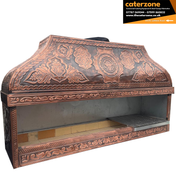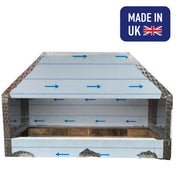Navigating the world of commercial kitchen equipment presents its own set of challenges. Making a wholesale catering equipment purchase is a significant decision for every professional involved in the food business. Buying in bulk isn’t a simple feat; it requires finding solutions to everyday problems, especially when it comes to economising.
Caterzone is no stranger to the challenges of selecting the right kitchen equipment. Buying in bulk not only results in direct savings and more efficient operations but also takes careful consideration of your budget, space, and anticipated equipment lifecycle.
Professional kitchens are increasingly turning to the concept of informed purchasing, carefully analysing everything from commercial-size ovens to specialty tools to gain meaningful insight into the cost benefits of wholesale solutions.
As professionals across the hospitality industry learn more about wholesale discounts and how they work, understanding the intricacies of catering equipment can help to reduce operating costs and significantly.
This article delves into buying in bulk for all the catering equipment you need to keep your commercial kitchen running efficiently. We will address key aspects of comparing prices, quality considerations, and finding the right platforms and approaches to wholesale purchasing. By the end, you should have some great ideas on how you can help your business.
Understanding the Wholesale Catering Equipment Economy
Investing in a bulk catering equipment purchase is a time-honoured practice that has helped many restaurants and catering companies gain cost control.
The entire concept of wholesale purchasing for any type of equipment is a sound financial process. However, it also requires some planning and analysis to achieve the desired return on investment.
Commercial Kitchen Wholesale Equipment: Financial Key Points
- Upfront cost
- Volume discounts
- Long-term operational expenses
- Depreciation
Financial Figures and ROI Analysis
Identifying ROI for the purchase of kitchen equipment in bulk requires a deep dive into the numbers. In addition to calculating upfront costs and potential savings, your business should consider factors like:
- Maintenance costs
- Energy efficiency
- Productivity gains
- Estimated useful life
Volume Discounts and Wholesale Bulk Order Perks
Volume discounts can translate into significant savings for your business.
Caterzone has special pricing for our clients who wish to place bulk orders, reducing costs by between 15% and 35% over the one-at-a-time approach.
Calculating Your ROI When Buying in Bulk
Calculating your return on investment when buying in bulk requires looking beyond the sticker price. Consider each investment or initial outlay and calculate your potential savings from discounts, reduced purchasing overheads, tax advantages and, importantly, the increased productivity that your new or replacement equipment will bring to the kitchen.
ROI is a function of cost divided by the saving potential multiplied by 100, and the result is expressed as a percentage.
Long-Term Cost Implications and Bulk Purchasing
Investing in wholesale purchasing is about the here and now, but it’s also a concept rooted in planning for the future. Understanding how the value of your equipment depreciates over time and how sound purchasing decisions can reduce kitchen operating costs over time is essential for any foodservice business.
Essential Catering Equipment: Making the Bulk Purchase Decision
Commercial kitchen bulk purchasing requires thoughtful planning and a detail-oriented approach. Buying wholesale catering equipment is more complex than checking on pricing and special deals.
Strategic Storage and Inventory Control
- Available storage space and tracking systems
- Keeping the storage area in optimal condition
- Preventing stock overage and ensuring supplies remain organised
- Stock rotation and equipment maintenance
- Proper storage conditions (cool, dry, climate-controlled)
Quality Considerations: Buying in Bulk
- Random sampling and testing
- Clear inspection protocols
- Supplier audits
- Acceptable quality level (AQL) standards
Systematic Maintenance and Equipment Lifecycle
- Scheduled servicing and preventive maintenance
- Stockpiling critical spare parts
- Monitoring and recording useful life
- Predictive maintenance capabilities
- Condition-based maintenance (CBM)
Conclusion
Making an informed decision when purchasing wholesale commercial kitchen equipment isn’t easy. A business needs to consider its operational requirements, its budget and its future growth and development before making a substantial investment in equipment and supplies.
Caterzone is here to make the toughest decisions you face that much easier by understanding the difficult financial trade-offs that must be made when it comes to balancing short-term cost with future gains.
FAQ
What are the primary benefits of bulk purchasing catering equipment?
Buying catering equipment in bulk results in significant savings. Discounts of 10% to 30% are common, reducing per-unit costs and ensuring continuity in your kitchen equipment.
How can businesses calculate the return on investment (ROI) for bulk equipment purchases?
Calculate ROI by comparing the investment cost to potential savings. Consider discounts, reduced purchasing overheads, tax advantages, and improved productivity. ROI = (Cost ÷ Savings Potential) × 100.
What storage considerations are critical when making bulk equipment purchases?
Adequate space, inventory tracking systems, proper storage conditions, and stock rotation are essential.
Are there quality risks associated with bulk purchasing catering equipment?
Yes. To mitigate, work with trusted suppliers, conduct sample checks, and have quality assurance protocols in place.
How can businesses manage maintenance for multiple equipment units purchased in bulk?
Create a detailed maintenance plan, consult manufacturers for servicing, and train staff in standard protocols across all units.
What financial considerations should businesses evaluate before bulk purchasing?
Weigh the initial capital investment against long-term savings, tax credits, depreciation, and cash flow impact.
Can small to medium-sized hospitality businesses benefit from bulk equipment purchasing?
Yes, SMEs can benefit by pooling purchasing power, forming joint buying groups, or working with suppliers that extend wholesale discounts to smaller orders.
What documentation should businesses maintain when making bulk equipment purchases?
Key documents include purchase contracts, equipment specs, warranties, delivery/shipping records, maintenance logs, and financial documents.
Bulk Purchasing Catering Equipment - Worth the Investment?
Navigating the world of commercial kitchen equipment presents its own set of challenges. Making a wholesale catering equipment purchase is a significant decision for every professional involved in the food business. Buying in bulk isn’t a simple feat; it requires finding solutions to everyday problems, especially when it comes to economising.
Caterzone is no stranger to the challenges of selecting the right kitchen equipment. Buying in bulk not only results in direct savings and more efficient operations but also takes careful consideration of your budget, space, and anticipated equipment lifecycle.
Professional kitchens are increasingly turning to the concept of informed purchasing, carefully analysing everything from commercial-size ovens to specialty tools to gain meaningful insight into the cost benefits of wholesale solutions.
As professionals across the hospitality industry learn more about wholesale discounts and how they work, understanding the intricacies of catering equipment can help to reduce operating costs and significantly.
This article delves into buying in bulk for all the catering equipment you need to keep your commercial kitchen running efficiently. We will address key aspects of comparing prices, quality considerations, and finding the right platforms and approaches to wholesale purchasing. By the end, you should have some great ideas on how you can help your business.
Understanding the Wholesale Catering Equipment Economy
Investing in a bulk catering equipment purchase is a time-honoured practice that has helped many restaurants and catering companies gain cost control.
The entire concept of wholesale purchasing for any type of equipment is a sound financial process. However, it also requires some planning and analysis to achieve the desired return on investment.
Commercial Kitchen Wholesale Equipment: Financial Key Points
- Upfront cost
- Volume discounts
- Long-term operational expenses
- Depreciation
Financial Figures and ROI Analysis
Identifying ROI for the purchase of kitchen equipment in bulk requires a deep dive into the numbers. In addition to calculating upfront costs and potential savings, your business should consider factors like:
- Maintenance costs
- Energy efficiency
- Productivity gains
- Estimated useful life
Volume Discounts and Wholesale Bulk Order Perks
Volume discounts can translate into significant savings for your business.
Caterzone has special pricing for our clients who wish to place bulk orders, reducing costs by between 15% and 35% over the one-at-a-time approach.
Calculating Your ROI When Buying in Bulk
Calculating your return on investment when buying in bulk requires looking beyond the sticker price. Consider each investment or initial outlay and calculate your potential savings from discounts, reduced purchasing overheads, tax advantages and, importantly, the increased productivity that your new or replacement equipment will bring to the kitchen.
ROI is a function of cost divided by the saving potential multiplied by 100, and the result is expressed as a percentage.
Long-Term Cost Implications and Bulk Purchasing
Investing in wholesale purchasing is about the here and now, but it’s also a concept rooted in planning for the future. Understanding how the value of your equipment depreciates over time and how sound purchasing decisions can reduce kitchen operating costs over time is essential for any foodservice business.
Essential Catering Equipment: Making the Bulk Purchase Decision
Commercial kitchen bulk purchasing requires thoughtful planning and a detail-oriented approach. Buying wholesale catering equipment is more complex than checking on pricing and special deals.
Strategic Storage and Inventory Control
- Available storage space and tracking systems
- Keeping the storage area in optimal condition
- Preventing stock overage and ensuring supplies remain organised
- Stock rotation and equipment maintenance
- Proper storage conditions (cool, dry, climate-controlled)
Quality Considerations: Buying in Bulk
- Random sampling and testing
- Clear inspection protocols
- Supplier audits
- Acceptable quality level (AQL) standards
Systematic Maintenance and Equipment Lifecycle
- Scheduled servicing and preventive maintenance
- Stockpiling critical spare parts
- Monitoring and recording useful life
- Predictive maintenance capabilities
- Condition-based maintenance (CBM)
Conclusion
Making an informed decision when purchasing wholesale commercial kitchen equipment isn’t easy. A business needs to consider its operational requirements, its budget and its future growth and development before making a substantial investment in equipment and supplies.
Caterzone is here to make the toughest decisions you face that much easier by understanding the difficult financial trade-offs that must be made when it comes to balancing short-term cost with future gains.
FAQ
What are the primary benefits of bulk purchasing catering equipment?
Buying catering equipment in bulk results in significant savings. Discounts of 10% to 30% are common, reducing per-unit costs and ensuring continuity in your kitchen equipment.
How can businesses calculate the return on investment (ROI) for bulk equipment purchases?
Calculate ROI by comparing the investment cost to potential savings. Consider discounts, reduced purchasing overheads, tax advantages, and improved productivity. ROI = (Cost ÷ Savings Potential) × 100.
What storage considerations are critical when making bulk equipment purchases?
Adequate space, inventory tracking systems, proper storage conditions, and stock rotation are essential.
Are there quality risks associated with bulk purchasing catering equipment?
Yes. To mitigate, work with trusted suppliers, conduct sample checks, and have quality assurance protocols in place.
How can businesses manage maintenance for multiple equipment units purchased in bulk?
Create a detailed maintenance plan, consult manufacturers for servicing, and train staff in standard protocols across all units.
What financial considerations should businesses evaluate before bulk purchasing?
Weigh the initial capital investment against long-term savings, tax credits, depreciation, and cash flow impact.
Can small to medium-sized hospitality businesses benefit from bulk equipment purchasing?
Yes, SMEs can benefit by pooling purchasing power, forming joint buying groups, or working with suppliers that extend wholesale discounts to smaller orders.
What documentation should businesses maintain when making bulk equipment purchases?
Key documents include purchase contracts, equipment specs, warranties, delivery/shipping records, maintenance logs, and financial documents.



